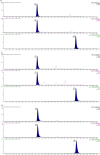Simultaneous detection of three hypoxia-inducible factor stabilizers-molidustat, roxadustat, and vadadustat-in multiple keratinized matrices and its application in a doping context
- PMID: 38992954
- PMCID: PMC12012410
- DOI: 10.1002/dta.3771
Simultaneous detection of three hypoxia-inducible factor stabilizers-molidustat, roxadustat, and vadadustat-in multiple keratinized matrices and its application in a doping context
Abstract
In a doping case, a top athlete challenged an anti-doping rule violation, involving molidustat. Molidustat is a stabilizing agent of the hypoxia-inducible factor (HIF) recently developed. It is currently undergoing clinical trials for anemia associated with chronic kidney disease. HIF stabilizers are banned at all times by the World Anti-Doping Agency (class S2). Because of their pharmacological proprieties, these new drugs can enhance athletic performance. The athlete's defense wanted to analyze multiple keratinized matrices as they allow long-term investigations. Requests concerning HIF stabilizers are constantly growing. We have therefore developed a liquid chromatography coupled with tandem mass spectrometry method to identify and quantify three molecules of this class: molidustat, vadadustat, and roxadustat. Thirty milligrams of keratinized matrices were incubated in 1 mL of pH 8.4 diammonium hydrogen phosphate buffer for 16 h at 40°C with 1 ng of testosterone-D3, used as internal standard. After extraction with ethyl acetate/diethyl ether (80/20), the organic phase was evaporated, and the dry residue was reconstituted in 30 μL of initial phase. The method was linear from 5 to 1000 pg/mg for the three analytes. Limits of quantification were 2, 0.5, and 5 pg/mg for molidustat, roxadustat, and vadadustat, respectively. The analysis of the athlete's head hair (collected 1 month after the urine test) showed a concentration of molidustat of 135 pg/mg, and his beard hair and his fingernails clippings contained 55 and 40 pg/mg, respectively.
Keywords: HIF; body hair; hair; molidustat; nails.
© 2024 The Author(s). Drug Testing and Analysis published by John Wiley & Sons Ltd.
Figures



Similar articles
-
Automated sample preparation for the detection and confirmation of hypoxia-inducible factor stabilizers in urine.Biomed Chromatogr. 2021 Feb;35(2):e4970. doi: 10.1002/bmc.4970. Epub 2020 Sep 6. Biomed Chromatogr. 2021. PMID: 32840903
-
Mass spectrometric characterization of the hypoxia-inducible factor (HIF) stabilizer drug candidate BAY 85-3934 (molidustat) and its glucuronidated metabolite BAY-348, and their implementation into routine doping controls.Drug Test Anal. 2017 Jan;9(1):61-67. doi: 10.1002/dta.2011. Epub 2016 Jun 27. Drug Test Anal. 2017. PMID: 27346747
-
Identification of Hypoxia-inducible factor (HIF) stabilizer roxadustat and its possible metabolites in thoroughbred horses for doping control.Drug Test Anal. 2021 Jun;13(6):1203-1215. doi: 10.1002/dta.3014. Epub 2021 Feb 23. Drug Test Anal. 2021. PMID: 33569900
-
Hypoxia-inducible factor stabilizers and other small-molecule erythropoiesis-stimulating agents in current and preventive doping analysis.Drug Test Anal. 2012 Nov;4(11):830-45. doi: 10.1002/dta.390. Epub 2012 Feb 24. Drug Test Anal. 2012. PMID: 22362605 Review.
-
Hypoxia-Inducible Factor Prolyl Hydroxylase Inhibitors: A Potential New Treatment for Anemia in Patients With CKD.Am J Kidney Dis. 2017 Jun;69(6):815-826. doi: 10.1053/j.ajkd.2016.12.011. Epub 2017 Feb 24. Am J Kidney Dis. 2017. PMID: 28242135 Review.
References
-
- World Anti‐Doping Agency . 2017 anti‐doping testing figures by laboratory [Internet]. Available from: https://www.wada-ama.org/sites/default/files/resources/files/2017_anti-d.... Accessed May 5, 2024.
-
- ITIA [Internet] . ITIA – independent tribunal sanctions Simona Halep for anti‐doping rule violations. Available from: https://www.itia.tennis/news/sanctions/independent-tribunal-sanctions-si.... Accessed February 26, 2024.
MeSH terms
Substances
LinkOut - more resources
Full Text Sources

